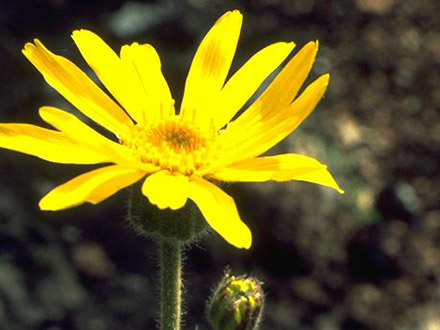Botanical name
Arnica montana L.
Family
Asteraceae (Compositae)
Common name
Arnica, Wolf’s bane, Leopard’s bane, Mountain tobacco, Mountain arnica
Information about the plant
The genus Arnica is primarily found in North America; in Europe, it is represented by the species Arnica montana. It grows on poorly calcareous forests and mountain meadows up to high mountain elevations in Central, Eastern and Northern Europe. The epithet montana (lat. montanus = mountain) refers to the plant’s preferred location in the mountains.
Arnica is an herbaceous perennial with a 4- to 6-leaved rosette lying flat on the ground. From its center grows a 20 to 60 cm tall, cross-opposite, leafy, hairy flower stalk. At its end are one or more flower heads, each with 12 to 20 yolk- to orange-yellow ray florets and up to 100 yellow disc florets. The flowering time is in June.
Wild collections of this highly valued medicinal plant have reduced populations, leading to its placement under conservation. Great breeding efforts were required to cultivate Arnica in fields, but this has now been achieved.
Medicinally used parts of plants (herbal drug)
The dried flower heads (arnica flowers - Arnicae flos) are used.
The commercially available herbal drug is mainly sourced from field cultivation, with a small extent coming from wild collections in Spain and some Balkan countries.
Constituents of the herbal drug
Arnica flowers contain sesquiterpene lactones (helenalin, dihydrohelenalin), flavonoids, caffeoylquinic acids, polyacetylenes and essential oil.
Quality of the drug
The quality of the following herbal drugs or herbal drug preparations is defined in the European Pharmacopoeia (Ph. Eur.):
- Arnica flowers (Arnicae flos)
- Arnica tincture (Arnicae tinctura)
Medical applications
Recognised medical use
The HMPC has classified arnica flowers as a traditional herbal medicinal product (see Traditional Use).
ESCOP: Treatment of bruises, sprains, and inflammation caused by insect bites; gingivitis and aphthous ulcers; symptomatic treatment of rheumatic complaints and muscular pain.
Traditional use
The HMPC has classified arnica flowers as a traditional herbal medicinal product (Article 16a of Directive 2001/83/EC). The HMPC concluded that, on the basis of its long-standing use, these arnica flower preparations can be used for the relief of bruises, sprains and localised muscle pain.
Herbal drug preparations in finished dosage forms
Oily extracts of arnica flowers in ointments; tincture for poultices and as an ingredient in ointments; alcoholic extracts of the whole plant in ointments, gels, and liquids for external use.
Dosage
Finished dosage form: see patient information leaflet.
Preparation of a tea
Pour 100 mL of hot water over 2 g of arnica flowers, infuse for 5 to 10 minutes, strain and leave to cool. Do not ingest, use only externally in the form of cooling compresses!
Notes
In case of existing allergies to the daisy family (Asteraceae), arnica flower preparations must be avoided (cross-allergy). Arnica flower preparations may only be applied to uninjured skin.
No safety studies are yet available for the use of arnica flowers during pregnancy and lactation; use in children under 12 years of age is not recommended due to a lack of evidence.
Side effects
With prolonged use or in the case of damaged skin, preparations with arnica flowers can cause edematous dermatitis with blistering. Therefore, Arnica should only be applied to uninjured skin. With prolonged use, eczema may occur even on intact skin.
Interactions
None known.
References
Herbal drug monographs
HMPC (2014), ESCOP (2019), WHO vol. 3
Further literature
Commentary on the European Pharmacopoeia (Arnica flowers, No. 1391; Arnica tincture, No. 1809)


